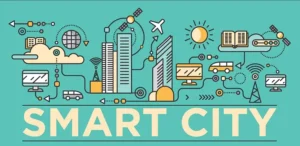
Why in news?
- The Smart Cities Mission (SCM), launched in 2015 with the ambitious goal of transforming 100 Indian cities, has come under scrutiny as its June 2024 deadline approaches.
- While progress has been made, with over 5,500 projects completed, significant challenges remain.
What is the Smart Cities Mission?
- The SCM is a centrally sponsored scheme aiming to create urban spaces with:
- Core infrastructure: Reliable power, water supply, sanitation, and transportation.
- Clean and sustainable environment: Focus on reducing pollution and promoting renewable energy.
- “Smart Solutions”: Utilizing technology to improve efficiency and citizen services.
- Sustainable and inclusive development: Ensuring equitable growth and social inclusion.
The Mission’s Structure:
- Area-based development: This involves redevelopment (e.g., Bhendi Bazar, Mumbai), retrofitting (e.g., Local Area Development, Ahmedabad), and greenfield projects (e.g., New Town, Kolkata).
- Pan-city solutions: Implementing ICT solutions across sectors like e-governance, waste management, and mobility.
Governance and Funding
- A Special Purpose Vehicle (SPV) led by a bureaucrat or MNC representative manages each city’s mission.
- Public-Private Partnerships (PPP) are envisioned for funding, but private participation remains low.
Current Status and Challenges:
- Lack of a Clear Definition: The mission lacks a universally agreed-upon definition of a “smart city.” This ambiguity creates confusion when allocating resources and prioritizing projects. Cities may interpret the concept differently, leading to proposals that might not align with the core objectives of sustainable, inclusive, and technologically driven development.
- Top-Down Approach and Accountability:The mission’s current structure raises concerns about democratic accountability. Reduced involvement of elected representatives in decision-making processes can lead to projects that don’t reflect the needs and priorities of citizens. Additionally, with a bureaucrat or MNC representative leading the SPV in each city, concerns arise about transparency and answerability to the public.
- Flawed City Selection Process:The competitive selection process for cities overlooks the diverse realities of urban India. Cities may prioritize “showpiece” projects to win selection, neglecting the existing challenges faced by different communities within their boundaries. This approach fails to address the needs of smaller towns and cities with unique development needs.
- Limited Scope and Funding:Estimates suggest the current funding allocated to the SCM is insufficient to achieve a significant and widespread urban transformation. The mission’s focus on a limited area within each city (often less than 1%) excludes a large portion of the urban population from experiencing the benefits of the project. Additionally, the low private sector participation through PPPs falls short of initial expectations, further hindering resource availability.
- Governance Issues with the SPV Model:The SPV model, created as a special entity to manage each city’s mission, raises concerns regarding its alignment with the 74th Constitutional Amendment Act. This act emphasizes the role of Urban Local Bodies (ULBs) in urban governance. The SPV structure may bypass traditional governance structures, potentially leading to a lack of ownership and long-term sustainability for the implemented projects.
- Displacement and Social Impact:Smart city projects can have unintended consequences, leading to the displacement of vulnerable communities like street vendors. This disrupts established social networks and livelihoods, raising ethical concerns and potentially exacerbating social inequalities. Additionally, a focus solely on infrastructure development can disrupt existing urban ecosystems, such as water channels, leading to unforeseen environmental problems like increased flooding.
Recommendations for Strengthening the Mission:
- Improved governance: Appointing dedicated CEOs with stakeholder representation and utilizing existing expertise.
- Project focus: Prioritizing pan-city projects and optimizing resource allocation.
- Digital security: Implementing robust safeguards against cyber threats and data breaches.
- Capacity building: Strengthening Urban Local Bodies (ULBs) in smaller cities and providing central government support.
- Project completion: Shifting focus from fund transfer to ensuring project execution and completion.
Conclusion
- The Smart Cities Mission holds immense potential for improving urban living in India.
- By addressing the identified challenges and adopting a more holistic and inclusive approach, the mission can empower cities to become truly smart and sustainable.
People also ask
Q1: What is the Smart Cities Mission (SCM)?
Ans: Launched in 2015, the Smart Cities Mission aims to transform 100 Indian cities by providing core infrastructure, a clean environment, and applying “smart solutions” for improved efficiency and citizen services.
Q2: What is the current status of the Smart Cities Mission?
Ans: The Smart Cities Mission deadline has been extended twice, with the current target set for June 2024. Over 5,500 projects have been completed, but challenges remain.
It appears that you know a lot about this topic. I expect to learn more from your upcoming updates. Of course, you are very much welcomed to my website UQ9 about Cosmetic Treatment.
Thank you so much for your kind words. If you found this website useful, please share it with your friends and family so they can read it too.
Hi there, I simply couldn’t leave your website without saying that I appreciate the information you supply to your visitors. Here’s mine 63U and I cover the same topic you might want to get some insights about Thai-Massage.
Thank you so much for your comments. Please share with your friends and family members so they can also gain some information.
Thank you for your sharing. I am worried that I lack creative ideas. It is your article that makes me full of hope. Thank you. But, I have a question, can you help me?